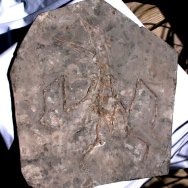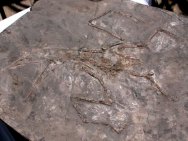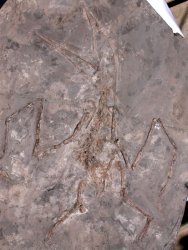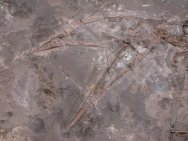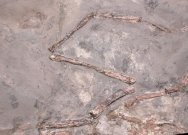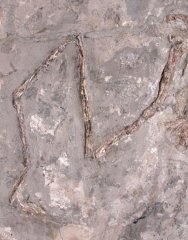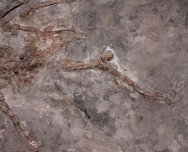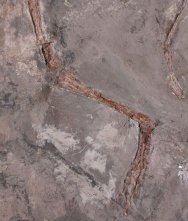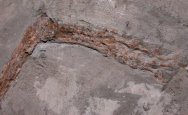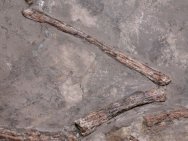Sinopterus
gui Class
Sauropsida, Order Pterosauria, Suborder Pterodactyloidea, Family Tapejaridae
Geological
Time: Lower Cretaceous (~110 m.y.a.)
Size (25.4
mm = 1 inch): 350 mm long (top of skull to tip of toes) 725 mm wingspan
(if outstretched) with a 115 mm skull
Fossil Site:
Jiufotang Formation, Dapingfang, Chaoyang, Liaoning
Province of China
 Description:
An Early Cretaceous pterosaur from Liaoning Province, this remarkably-well
preserved specimen is a member of the Tapejaridae known as Sinopterus
gui. The taxon was described in 2002 (Acta Palaeontologica Sinica,
Vol 42, No 3, pp 442-447) as the second member of this unusual family
of Pterosaurs whose namesake genus (Tapejara) comes from the slightly
younger Santana Formation of Brazil (see drawing Tapejara Description:
An Early Cretaceous pterosaur from Liaoning Province, this remarkably-well
preserved specimen is a member of the Tapejaridae known as Sinopterus
gui. The taxon was described in 2002 (Acta Palaeontologica Sinica,
Vol 42, No 3, pp 442-447) as the second member of this unusual family
of Pterosaurs whose namesake genus (Tapejara) comes from the slightly
younger Santana Formation of Brazil (see drawing Tapejara 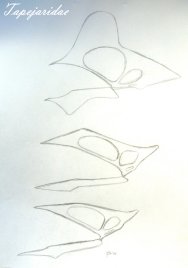 wellnhoferi,
top; Sinopterus dongi, middle, Sinopterus gui, bottom). The Tapejaridae
are thought to have had an elaborate non-bony crest. A hint of that
seems to be present beginning about the front of the preorbital
opening of the skull, then widening out to 1.5X the skull depth wellnhoferi,
top; Sinopterus dongi, middle, Sinopterus gui, bottom). The Tapejaridae
are thought to have had an elaborate non-bony crest. A hint of that
seems to be present beginning about the front of the preorbital
opening of the skull, then widening out to 1.5X the skull depth
 before
tapering off at the back of the skull. This one differs from the
conspecific Sinopterus dongi by having a less steep forward edge
of the skull. Both are known from nearly complete specimens such
as you see here. The preservation is excellent for a creature in
which the bones were hollow and paper thin to minimize weight. This
specimen is quite detailed, with most bones present in articulation
as found in life. All the material here is original to this specimen.
As is commonly the case, there are repaired matrix cracks as a result
of field collection. This is a fine representative of the taxon
whose largest known specimen has a 1.2 meter wingspan. before
tapering off at the back of the skull. This one differs from the
conspecific Sinopterus dongi by having a less steep forward edge
of the skull. Both are known from nearly complete specimens such
as you see here. The preservation is excellent for a creature in
which the bones were hollow and paper thin to minimize weight. This
specimen is quite detailed, with most bones present in articulation
as found in life. All the material here is original to this specimen.
As is commonly the case, there are repaired matrix cracks as a result
of field collection. This is a fine representative of the taxon
whose largest known specimen has a 1.2 meter wingspan.
Wang
Xiaolin & Zhou Zhonghe:
A new pterosaur (Pterodactyloidea, Tapejaridae) from the Early Cretaceous
Jiufotang Formation of western Liaoning, China and its implications
for biostratigraphy
Institute
of Vertebrate Paleontology and Paleoanthropology, Chinese Academy
of Sciences, Beijing 100044, China
|
|


 before
tapering off at the back of the skull. This one differs from the
conspecific Sinopterus dongi by having a less steep forward edge
of the skull. Both are known from nearly complete specimens such
as you see here. The preservation is excellent for a creature in
which the bones were hollow and paper thin to minimize weight. This
specimen is quite detailed, with most bones present in articulation
as found in life. All the material here is original to this specimen.
As is commonly the case, there are repaired matrix cracks as a result
of field collection. This is a fine representative of the taxon
whose largest known specimen has a 1.2 meter wingspan.
before
tapering off at the back of the skull. This one differs from the
conspecific Sinopterus dongi by having a less steep forward edge
of the skull. Both are known from nearly complete specimens such
as you see here. The preservation is excellent for a creature in
which the bones were hollow and paper thin to minimize weight. This
specimen is quite detailed, with most bones present in articulation
as found in life. All the material here is original to this specimen.
As is commonly the case, there are repaired matrix cracks as a result
of field collection. This is a fine representative of the taxon
whose largest known specimen has a 1.2 meter wingspan.